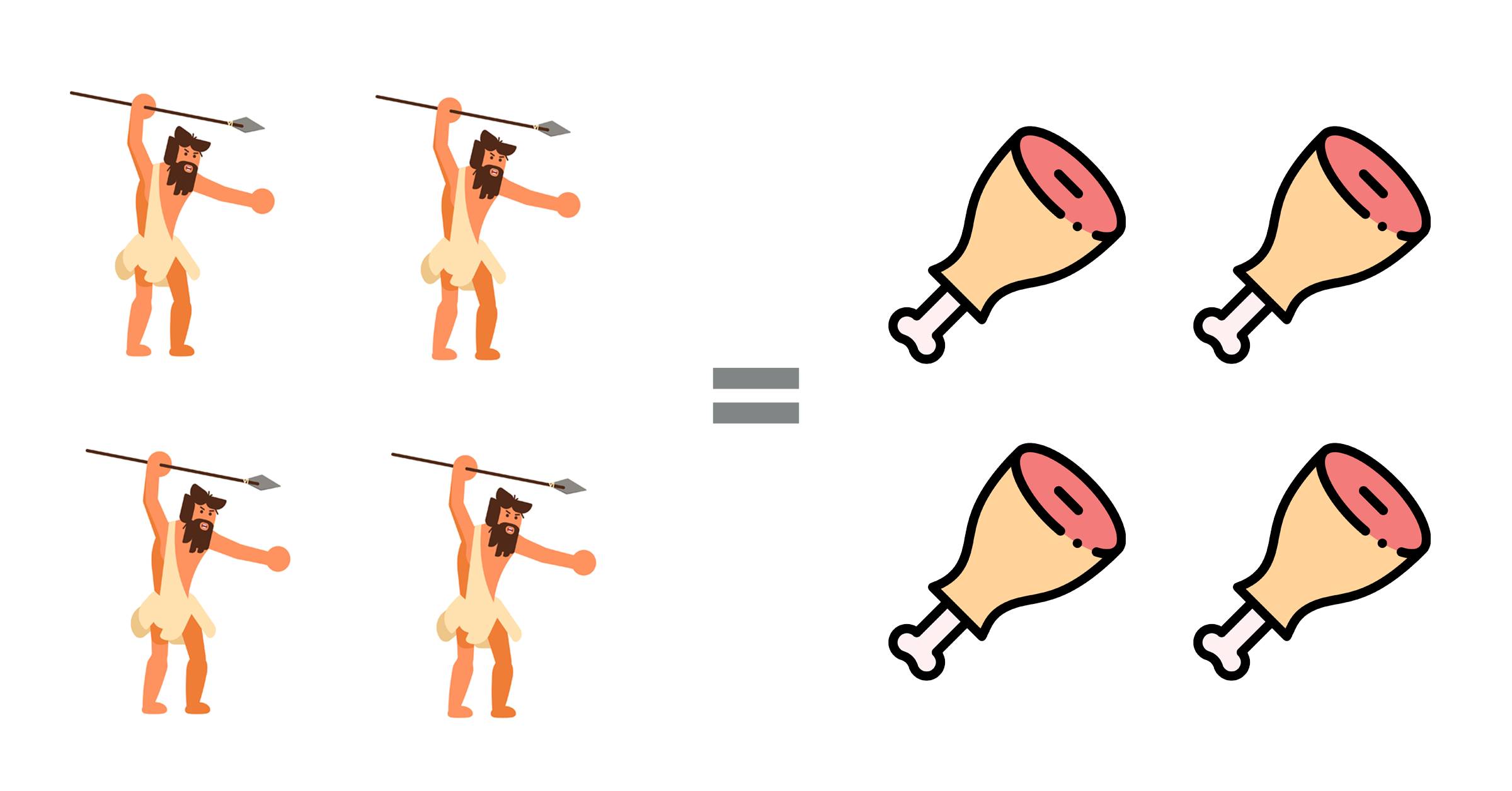
Employing a great salesperson is a sure fire way to hit your sales targets - right? Well... there’s a 57% chance that it’s not, but a 43% chance that it is. In this post I’m going to help you look at where you could be going wrong in hitting your sales targets - if you think that employing another sales person is the answer you are looking for, this post might change your perspective.
If you’re tight for time, bookmark this page and come back to it when you’ve got a spare 10 minutes to truly digest the information in this post.
First let’s review two scenarios to give some context to the question:
- You employ a sales superstar and they have a ready made pipeline of opportunities to bring to the table. In addition, as a higher level manager your targets aren’t going to be increased as soon as the new sales person helps you hit them - otherwise you’ll forever be chasing new sales superstars to fill the gaps.
- The salesperson is part of the 57% that don’t hit their sales quota, meaning you’ll have around a 1 in 3 chance of achieving your targets by employing another sales person.
With those two scenarios in mind - let’s get into the deeper questions that remain.

Why the answer is always employ another sales person
Imagine you’re the head of a tribe living out on the plain in Africa. Food is pretty scarce, but there’s always some large antelopes out there on the arid planes. Your hunters just can’t hunt enough to keep the tribe fed all year round, so you need to get one of the young men trained up into a prime hunter to keep everyone fed.
The great thing about your hunters is that you can see exactly how they’re doing. The ones that are bringing back the meat for the tribe, the ones that are trailing behind and that really need to stay at home to train up the new hunters who’ll then have the energy to run for longer.
Your hunters are a known quantity, if one isn’t ready to make their contribution then a good talking to usually gets them back on track. If they really aren’t up to scratch you can easily kick them out of the tribe for not pulling their weight and you’ll have someone else eager to take their place.
As long as you keep a team that performs, your sales people can keep your whole business fed and thriving. It makes a lot of sense.
However, there’s a few problems:
- What if the animals aren’t interested in your lands and go off elsewhere?
- What if other tribes come onto your lands and are better hunters than your team, taking the prime animals?
- What if your hunters all get a bit lazy and don’t bring enough meat home?
- What if your tribe wants to grow, but can’t because the hunters can only hunt so much meat each day?
Why employing another sales person is the wrong answer

Often when you have the choice of employing another sales person, you have other ways of spending the same investment.
If you need and want only short term sales, then employing another sales person is probably the smart choice. However, if you’re looking to grow a much bigger business that will thrive into the future, then you’ll want to change your thinking.
The trouble with sales is that each salesperson can only realistically bring in a certain amount of business, because it is dependent on the amount of time they can put in.
Sure it varies with a sales person’s skill and whether they are landing large accounts or smaller accounts. However, when it boils down to it, you’ll have an average quota that you are expecting each of your salespeople to bring in. So with sales, if you want to increase your total quota, you’ll have a linear relationship with the number of salespeople you need.
Linear growth isn’t a great model for business growth. Really you want a model that can deliver exponential growth.
And one of the key ingredients of non-linear growth is marketing - which by definition is a strategy used to get more customers, don’t just think “social media” and “SEO” in and of themselves, they are useless without being tied into a proper strategy that aligns with the goals of sales.
What you really need to focus on
Marketing is a bit like an ear of corn for that tribe on the African plains. In its first year an ear of corn could be devoured by one person as an appetiser.
Now if that ear of corn is planted, it could grow a small field of corn that in 3 years could grow enough corn to feed the whole tribe and buy them enough meat that they won’t need to hunt if they don’t want to.
In the same way your marketing probably won’t make a huge difference in its first year, but if you keep on investing in it and building it out, in 3 years it can provide all the leads you need to meet your sales targets and invest in more marketing to keep up your growth curve.
Let’s say you write a useful blog post that answers one of the common questions your prospects ask. That blog post gets a lead in every month, it can keep doing the same month after month for years, as long as you keep it up to date and well maintained.
Each month, or each week you can add another resource that performs similarly and before long you have more leads coming in than your sales people could generate working all day, every day on prospecting.
What’s better, these leads actually want to speak with your sales people meaning your sales team have much more time to spend on high quality conversations, rather than wasting their time with people who don’t really want to speak with them.
Why you still need sales people

Sales still plays an important role. Prospects like having help to buy - when they are ready. Sure your customers can research their problem to the ends of the earth online, but they still like the reassurance that their research is correct. Even the simplest things can become a minefield when you start to research them online, as often as not it can be as overwhelming as it is informing. Plus, it’s reassuring to know that there is a human behind your website.
When you use this model and your sales team are well fed with informed leads coming to them, they can spend much more of their time with these high quality prospects doing what they do best - selling, or helping customers buy. They don’t need to waste their time trying to convince people who aren’t ready to buy. They work with people who are ready to buy and help them to make the best decision.
It is a much more efficient way of working.
A bit like the hunters in our fictional tribe. If they are well fed with corn from the village, they can spend more time hunting the prime game to bring back to the village for everyone to enjoy. If they were solely responsible for feeding the whole tribe they’d probably need to consume half of what they hunted, which would mean there would be less meat for the whole village to enjoy.
The growth of the tribe would also be restricted by the number of hunters and the amount of meat they can hunt for the tribe.
With the farming model, more food can be grown for the tribe and with good farming practices the tribe are actually much more in control of the amount of food that they can produce compared with the hunting model.
Why sales and marketing need to be aligned
There are a few things to watch out for with this model.
The first is that sales people are hunters. They love the chase and the glory that comes with returning to the tribe with the kill. It’s exciting and they get a lot of respect from the tribe for the role that they play. It is their unique skills that feed the tribe and they thrive on that.
When that gets taken away from them, it can be difficult as the rug is pulled from under them. Their unique skills are questioned and they’ll defend them to the end of the earth.
- They’re skilled and brave hunters after all.
- It’s true that without them, the model would be a lot less successful.
- It is best when sales and marketing are aligned and work together.
Sales are speaking with the customers all day every day. They have unique insights into the customers goals as well as their problems and challenges in achieving those goals.
They understand which marketing messages are hitting the mark and which aren’t. They know what is working and what isn’t.
They can spot a lead that is ready to buy and one that isn’t - almost at a glance. If the situation isn’t handled right, they’ll keep all of this information to themselves. They won’t share it with marketing as it’s their power to bring in more business and take more of the glory.
The thing is this information is some of the most valuable information marketing can ever have. They rarely speak with customers, they don’t have the benefit of these unique insights, unless they get it from sales. When they do get these golden nuggets of information, they can use it to generate even better leads for sales. Which in turn means that sales can spend more of their time with high quality leads, rather than wasting their time with the low quality ones.
Which in turn means that you need fewer sales people to bring in more business.
The best time to employ another salesperson is when your existing team can’t handle the volume of quality leads that are being delivered to them by marketing.
It’s not lazy sales, it’s smart sales.
It may not be quite as exciting for your skilled hunters, but it’s a lot smarter and more profitable for your business.


